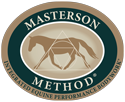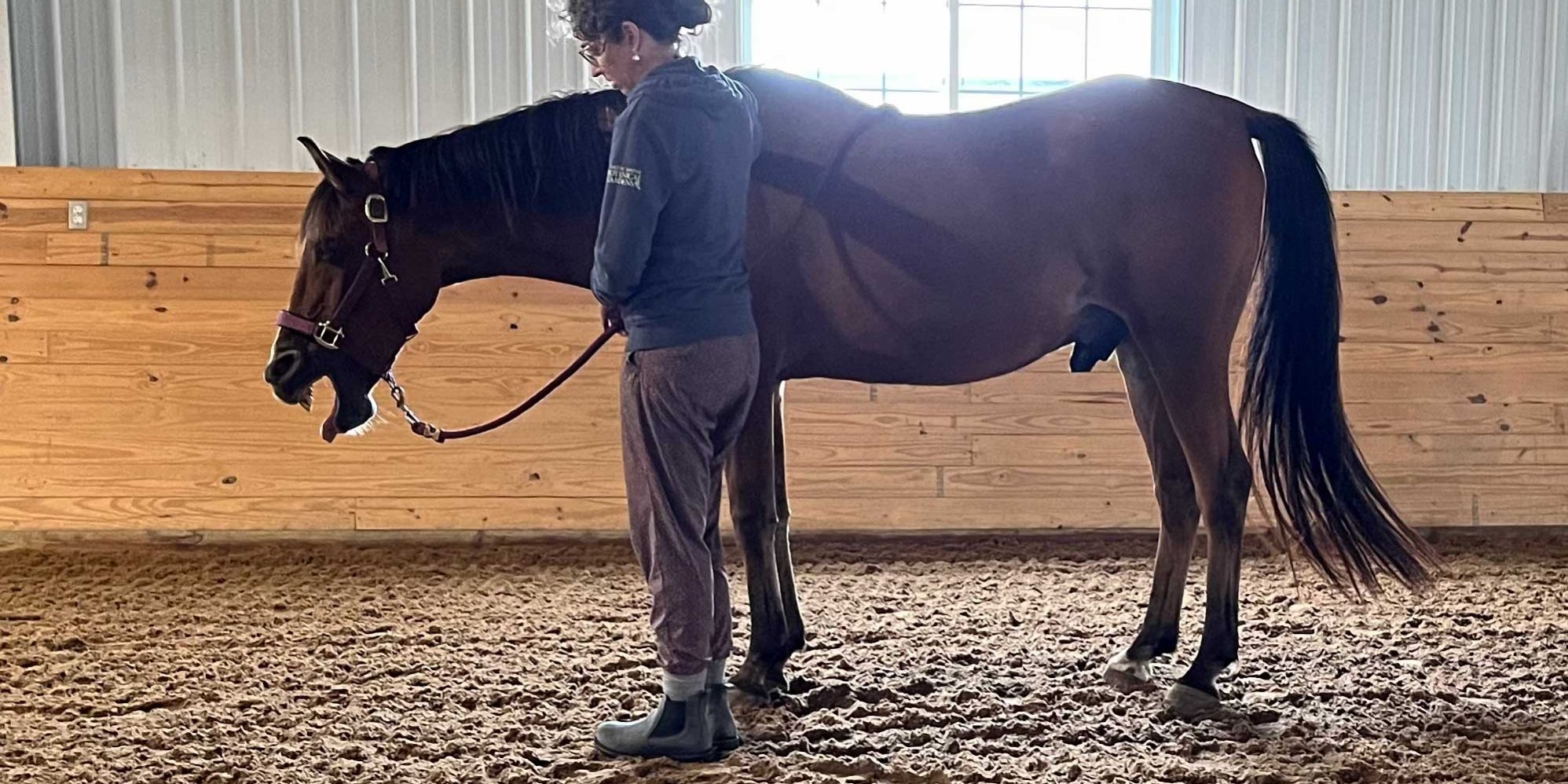by Megan Dushin
Have you heard of SRSR? It’s the acronym we use in The Masterson Method for “Search for a Response, Stay for a Release.” It’s one of the most basic practices we employ and what makes The Masterson Method so unique.
Responses and releases can typically be seen (or heard, or even smelled in some cases!). A response could be an eye blink, lip quiver, or even the tiniest jaw movement or muscle tightening, while a release could be licking and chewing, resting a hind leg, passing gas, or yawning. We use an incredibly light touch, go slowly, and follow the horse’s responses.
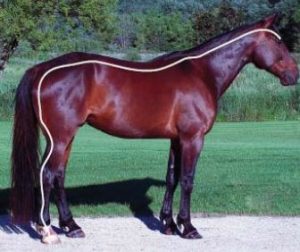
Image of horse with the bladder meridian drawn on.
SRSR is what we use when we do the Bladder Meridian Technique, often the first technique people learn when they discover The Masterson Method. It is also the primary technique we use in equine-assisted services (EAS) programs to benefit the horse, and potentially the human!
Since 2019, we have been offering the Masterson Method Equine Specialist (MMES) certification designed for those working in EAS programs. We show EAS professionals how they can offer their horses a new activity with program participants while being supported in releasing tension. Notice that we’re speaking from the horse’s perspective here: that is the primary principle of The Masterson Method. It’s 100% about the horse, and yet, it has benefits for the human as well.
While many in EAS programs are accustomed to using horses to help people, we invite programs to consider giving program participants the opportunity to help horses through this interactive and light-touch bodywork. Offering the Bladder Meridian Technique to a horse can be particularly beneficial for participants who are seeking relationship healing, trauma healing, addiction recovery, and healing from other challenges. We teach EAS professionals to serve these people by showing them how to give back to the horse (we also teach them select techniques they can perform with their EAS horses).
To become certified as an MMES, you first complete the hands-on 3-day bodywork course, and then complete the Fieldwork component. As an MMES Course Instructor and Fieldwork Mentor, I have been overjoyed to see students develop through the program. Students I encounter are discovering things about their horses and themselves that are opening new ways of being and communicating, and their case studies reflect their knowledge and preparedness to serve EAS programs in their community.
Amy Harris and Tracey Englebright are two recent certified Masterson Method Equine Specialists that come to mind. In their final case study—facilitating someone who is unfamiliar with The Masterson Method in how to give back to the horse using the Bladder Meridian Technique—they explain and reflect on the facilitation experience from start to end. Here are a few excerpts from their final case studies.
Amy Harris, MMES
Here’s an excerpt from Amy’s final case study:
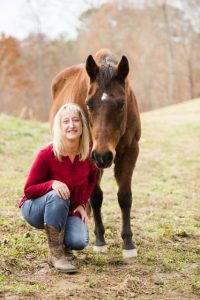 …I explored the horse’s use of non-verbal cues and asked the participant what parts of the body the horse uses to talk to us. We listed together some non-verbal responses we would look for. We then discussed releases and what we can look for from the horse. I concluded that we need to be in conversation with the horse and be sure we are actively listening by watching for their non-verbal responses….
…I explored the horse’s use of non-verbal cues and asked the participant what parts of the body the horse uses to talk to us. We listed together some non-verbal responses we would look for. We then discussed releases and what we can look for from the horse. I concluded that we need to be in conversation with the horse and be sure we are actively listening by watching for their non-verbal responses….
…Spirit was rather stoic and wasn’t too demonstrative in his releases, but would sigh or have a lip quiver and Elizabeth continued the BM. She would occasionally ask me if she was touching in the correct position on the body, which I confirmed. When we were around the hock, left-side, Spirit did something I hadn’t seen before – he raised his head, arched his back, spread out his legs and basically did a full body stretch, to the point that he had a full body quiver. He then did a lick and chew and then a yawn and lowered his head. We let him move and got a couple more yawns. It was magical.
Elizabeth was very excited about this technique… and indicated I explained it very well and was a good teacher, but perhaps she was being polite :).
We don’t think she was just being polite, Amy. Good work!
(See More About Amy)
Tracey Englebright, MMES
Here’s an excerpt from Tracey’s final case study:
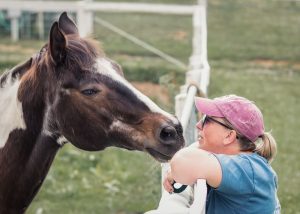 As Rebecca and I walked out to the field to get Chica, I explained The Masterson Method… and how it can potentially create a connection between you and the horse…. We discussed responses… and releases…. We also took some time to ground ourselves before we began our session by taking some deep breaths.
As Rebecca and I walked out to the field to get Chica, I explained The Masterson Method… and how it can potentially create a connection between you and the horse…. We discussed responses… and releases…. We also took some time to ground ourselves before we began our session by taking some deep breaths.
…Within a few minutes, Chica released in the poll area. In the cervical [neck] area, Chica was fidgeting…. Rebecca asked what to do, so I told her it was okay to [allow her to] walk [in a circle] and just lighten her touch a bit. She did, and Chica released. While Rebecca was over the withers area, we both could see that Chica wanted to release but just wouldn’t…. Rebecca stepped back and within 15 seconds, Chica yawned and shook her entire body. I explained that sometimes horses just need space to let go…. By the time Rebecca moved to the right side of the body, she was like an old pro. She was so into the session and was so focused on Chica and Chica was so into her body and focused on Rebecca. It was amazing to be the facilitator and to see the magic happen between a person and a horse.
(See More About Tracey)
It amazes me how simple this work is, and yet how much it helps us shift our mindset from DOING to BEING. When you slow down, recognize the micro-movements in the horse’s facial expressions, and provide space for the horse to feel safe as they sense and release any discomfort, you inevitably create a trusting relationship while improving physical and mental comfort in the horse. I expect you will also improve your own self-awareness and comfort in the process!
That’s the magic of SRSR, for both horse and human.
Want to learn more? Explore our upcoming MMES courses, search for an MMES in your area, or email us at .
This article was written by Megan Dushin, MMCP and MMES. Megan has been teaching Masterson Method Equine Specialist Courses since 2019. Her first exposure to The Masterson Method was a webinar held in 2016 about the use of this bodywork in equine-assisted services programs. She was hooked the moment she saw Jim’s way of being around and listening to horses. For more about the author, go to Megan Dushin, MMCP, MMES.
